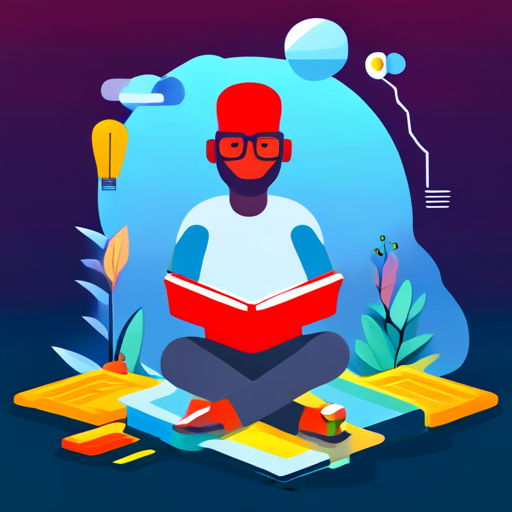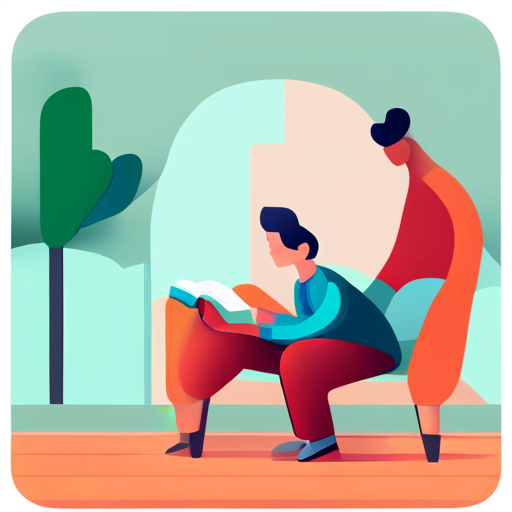Do you struggle with staying focused while reading due to visual distractions? Whether it’s a brightly lit room or a cluttered desk, visual distractions can make it difficult to concentrate on the text in front of you.
But fear not, there are solutions that can help you overcome these distractions and improve your reading experience.
In this article, we will explore some of the most effective solutions for overcoming visual distractions while reading. From creating a distraction-free environment to using technology to your advantage, we’ve got you covered.
So, grab your favorite book and let’s dive in!
Table of Contents
Create a Distraction-Free Environment

To effectively focus on reading, it’s crucial to establish an environment that’s devoid of any interruptions or diversions. Start by finding a quiet space where you can read without being disturbed. This could be a cozy corner in your home, a library, or a park.
Make sure the environment is well-lit, comfortable, and free of any distractions such as music, TV, or social media. Another important factor to consider is your posture. Sit in a comfortable chair and maintain a good posture to avoid any distractions or discomfort.
You can also try using a bookstand or a tablet holder to keep your reading material at eye level. This will reduce eye strain and help you maintain focus for longer periods. Lastly, it’s essential to limit any external distractions.
Turn off your phone or put it on silent mode, close any unnecessary tabs on your computer, and avoid any other distractions that could pull your attention away from your reading. By creating a distraction-free environment, you’ll be able to focus on your reading and comprehend the material better.
So, take the time to set up a comfortable and quiet space that works for you.
Use Technology to Your Advantage

Tech can be a helpful tool for staying focused when reading, so it’s worth exploring how you can leverage it to your advantage.
The first thing you can do is use an e-reader or tablet instead of a physical book. With an e-reader, you can adjust the font size and style, as well as the background color, which can reduce eye strain. Additionally, many e-readers have a built-in dictionary and thesaurus, so you can quickly look up words without having to leave the page.
Another way to use technology to your advantage is by using browser extensions that block distracting websites. If you’re prone to checking social media or news websites while reading, consider installing an extension like StayFocusd or Freedom. These extensions allow you to set specific times when you can access certain websites, which can help you stay focused on your reading.
Finally, you can use apps like Forest or Focus@Will to help you stay on task. Forest is a productivity app that encourages you to stay focused by planting a virtual tree that will die if you leave the app. Focus@Will is a music app that plays instrumental music specifically designed to help you focus.
By using technology to your advantage, you can overcome visual distractions and make the most of your reading time.
Practice Mindfulness Techniques

You can improve your focus and concentration while reading by practicing mindfulness techniques. Mindfulness is a mental state that involves being present and fully engaged in the moment. It can help you stay focused on the task at hand and reduce distractions.
One effective mindfulness technique is to focus on your breath while reading. Take deep breaths in and out and concentrate on the sensation of the air moving in and out of your body.
Another useful mindfulness technique is to pay attention to your surroundings. Notice the sounds, smells, and sensations around you while you read. This can help you stay present and focused on the reading material. You can also try visualizing yourself as a character in the book or imagining the setting of the story. This can help you become more immersed in the reading experience and reduce distractions.
Finally, remember to take breaks while reading. You don’t have to read for hours on end without a break. Taking a five-minute break every hour or so can help you stay focused and reduce eye strain. During your break, practice a mindfulness technique such as taking a short walk or doing some deep breathing exercises.
By incorporating these techniques into your reading routine, you can improve your focus and concentration and enjoy a more fulfilling reading experience.
Develop Good Reading Habits

You can develop good reading habits by setting realistic goals, taking breaks, and staying engaged with the material.
Start by setting achievable goals for yourself, such as reading for 30 minutes a day or completing a certain number of pages each week.
Don’t forget to take breaks when you need them and stay engaged with the material by actively questioning and summarizing what you’ve read.
Set Realistic Goals
Let’s be honest, we all want to read with less frustration and more ease, and setting realistic goals is the key to achieving this. You may have the desire to read a whole book in one sitting, but if you have other responsibilities or a short attention span, this may not be realistic.
Instead, try setting a goal to read for 30 minutes each day. This way, you’ll make progress without feeling overwhelmed or discouraged.
Another way to set realistic goals is to break down larger reading assignments into smaller sections. For example, if you have a 200-page book to read, aim to read 20 pages a day for 10 days. This will make the task seem less daunting and more achievable.
By setting realistic goals, you’ll be able to read more consistently and enjoyably without feeling burnt out or frustrated.
Take Breaks
Taking breaks during reading sessions can enhance the overall experience and allow for better retention of information. It’s important to remember that reading for extended periods of time can be tiring on both your eyes and your mind.
Taking short breaks every 20-30 minutes can help prevent eye strain and mental fatigue. During these breaks, try to engage in an activity that allows your eyes and mind to rest, such as taking a walk, stretching, or simply looking away from your reading material for a few minutes.
It’s also important to take longer breaks at regular intervals, such as every hour or so. Use this time to recharge your mind and body by engaging in a relaxing activity, like meditation, listening to music, or taking a power nap.
These longer breaks can help prevent burnout and allow you to return to your reading material with a fresh perspective. Remember, taking breaks doesn’t mean you’re slacking off; it’s a necessary part of any successful reading session.
Stay Engaged with the Material
To fully absorb and enjoy what you’re reading, try to actively engage with the material by asking questions, making connections to your own experiences, and visualizing the concepts in your mind. This will not only help you stay focused on the content, but it’ll also enhance your understanding and retention of the information.
When you come across a new idea or concept, take a moment to ask yourself questions about it. What’s it? How’s it work? What’re the implications? This’ll help you process the information in a meaningful way and make it more memorable.
Another way to stay engaged with the material is to make connections to your own experiences. Try to relate what you’re reading to something you’ve experienced in your own life or something you’re passionate about. This’ll help you connect with the content on a personal level and make it more interesting to read.
Additionally, visualizing the concepts in your mind can also be a powerful tool for enhancing your understanding and retention of the material. Try to create mental images of the ideas you’re reading about and how they relate to each other. This’ll help you see the big picture and make it easier to remember the details.
Frequently Asked Questions
How long does it take to see improvements in reading focus when implementing these solutions?
When you start implementing solutions to overcome visual distractions while reading, you can expect to see improvements in your focus relatively quickly.
Depending on the severity of your distractions and the solutions you choose, you may notice a difference in your ability to concentrate within a few days or a couple of weeks.
It’s important to remember that consistency is key when it comes to improving your reading focus. By making a conscious effort to implement these solutions regularly, you’ll be able to train your brain to tune out distractions and stay focused on the task at hand.
Can these solutions be applied to other forms of media consumption, such as watching videos or browsing the internet?
If you struggle with visual distractions while consuming media, such as watching videos or browsing the internet, the solutions discussed for improving reading focus may also be applicable.
By implementing techniques such as reducing background noise, minimizing visual clutter, and taking regular breaks, you can improve your ability to stay focused and engaged with the content you’re consuming.
Additionally, practicing mindfulness and being intentional with your media consumption can also help reduce distractions and improve overall focus.
Are there any specific types of technology or tools that are particularly effective in reducing visual distractions while reading?
Looking for ways to reduce visual distractions while reading? There are a variety of technology and tools that can help.
For example, you might try using a browser extension that blocks ads and other distracting content, or using a reading app that allows you to adjust the font size and spacing to make it easier to focus on the text.
Additionally, you might consider using a dedicated e-reader device, which typically offers a distraction-free reading experience.
Whatever your approach, the key is to find a solution that works for you and helps you stay focused on the task at hand.
Can these solutions be helpful for individuals with attention deficit disorders or other cognitive challenges?
If you have an attention deficit disorder or other cognitive challenges, solutions for reducing visual distractions while reading can be incredibly helpful.
Certain technologies and tools, such as noise-cancelling headphones, color filters, or even just adjusting the lighting in your environment, can make a big difference in your ability to focus on the text.
Additionally, developing good reading habits, such as taking frequent breaks or using a bookmark to keep your place, can also help you stay engaged with the material.
Ultimately, finding what works best for you may take some experimentation, but the effort’s well worth it if it means being able to read more effectively and efficiently.
Is there a specific time of day or environment that is best for implementing these solutions to maximize their effectiveness?
To make the most of solutions for overcoming visual distractions while reading, it’s important to consider the time of day and environment in which you’re reading.
For example, if you know you struggle with distractions in the afternoon, try reading in the morning or evening instead.
Additionally, finding a quiet and well-lit space can help you focus and minimize visual distractions.
By being intentional about when and where you read, you can maximize the effectiveness of the strategies you use to overcome visual distractions.
Conclusion
Congratulations! You’ve made it to the end of the article! You now understand how visual distractions can interfere with your reading experience and the solutions that can help you overcome them.
By creating a distraction-free environment, using technology to your advantage, practicing mindfulness techniques, and developing good reading habits, you can enhance your reading experience and increase your focus.
Remember, reading is not only a way to gain knowledge and information, but it’s also a way to relax and escape from the stresses of everyday life.
So next time you sit down to read, try implementing some of these solutions and see how they work for you. Happy reading!
